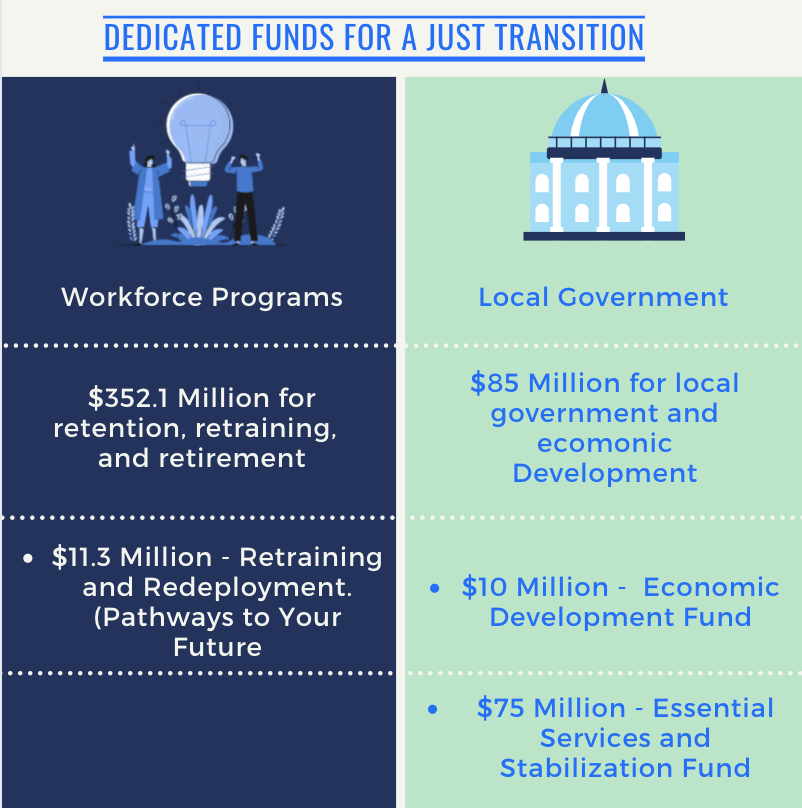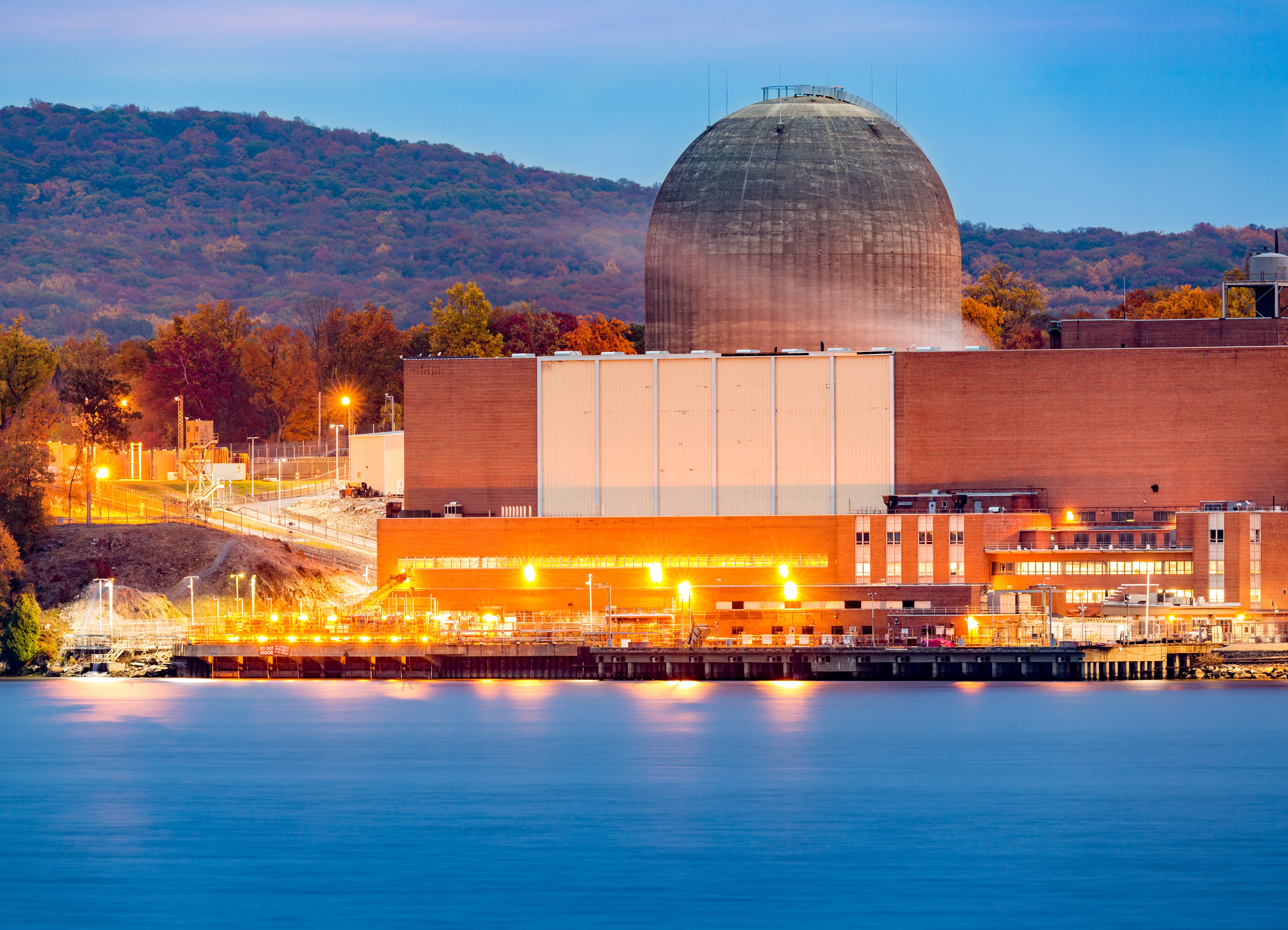Nuclear power remains a controversial topic in energy. Should or shouldn't it be produced? Regardless, states like California and New York are closing down their nuclear power plants to replace the energy demand with cheaper renewable energy. Solar and wind energy is almost a third of the cost of nuclear energy. Solar costs $29-42 per MWh (though rooftop is significantly more expensive). Wind costs $26-$54 per MWh. Nuclear costs a staggering $151-198 per MWh. It is no longer economically feasible to keep producing nuclear energy, and the U.S. is decommissioning 16 nuclear power plants. WDI’s primary interest in the area of energy is with the workforce and ways they can be supported.
At WDI, we've often talked about the concept of Just Transition, and the key elements we believe comprise of this include:
1. No economic harm to workers or communities.
2. Create jobs that have family sustaining wages and benefits. Renewable energy jobs and jobs in other emerging sectors must be good jobs. The transition cannot be a race to the bottom.
3. Incorporate local economic development
4. Authentic training for jobs in good paying fields that will actually be in the community in which displaced workers live
5. Knowledge sharing
6. Labor standards and collective bargaining
7. Social dialogue
8. A sector approach customized to regions and work process.
9. The process must be equitable and inclusive.
As Indian Point Nuclear Facility is closing and laying off over 300 workers in May, WDI took the opportunity to look at the successful closure plan at Diablo Canyon Power Plant (DCPP) in California to see what lessons we could learn. We can draw similarities between the two power plants. They are both outside the two largest U.S. cities, and they produce about the same amount of electricity. Indian point was commissioned in the 60s and 70s between three units. In contrast, Diablo Canyon was commissioned in the 80s, with both units beginning around the same time. Indian Point Nuclear Facility has already closed two units and employs 750 workers at the last remaining unit, while DCPP has not closed any units yet, therefore employing more workers, about 1,300. Our interest was to see how many elements of a WDI's Just Transition best-practice scenario were included in planning around Diablo Canyon's closure. New York can build off of the DCPP closure plan at Indian Point to create a strong workforce transition plan.
“We are all on the same side. As I’ve said to you it’s an emotional and personal topic to so many. If we broaden our view, we can bring more people under the tent.” - John Murphy, United Association, Climate Jobs NY Summit
Principles to Achieve a Just Transition
Labor standards and collective bargaining and Social dialogue
When DCPP's closure was announced, representatives from a diverse set of stakeholders came together as a coalition to formulate a joint proposal. Stakeholder's started a dialogue between businesses, workers, and environmental groups to ensure almost everyone has a voice and their concerns were addressed. The joint proposal addressed the workers’ needs and the loss of property taxes for local governments while being mindful of what PG&E can pay to each of these groups for a smooth transition. Collective bargaining was represented by IBEW 1245, who negotiated a job transition package for the plant workers. The joint proposal was then presented to the governor, and it became California Senate Bill (S.B.) 1090.
No economic harm to workers or communities
The overarching goal of a just transition is not to harm the workers and the community. DCPP’s closure is accomplishing this through SB 1090. In addition to SB 1090, Senate Bill (SB 968) requires a third-party study (performed by UC Berkeley) of the economic and workforce impacts. The purpose of this study is to evaluate the economic impacts of closing DCPP and change the plan, if necessary. UC Berkeley's study found that while there will be a significant negative economic impact, the opportunities that will come from PG&E's payouts (discussed below) will mitigate the losses, and the effect will be modest.
Authentic training for jobs in good paying fields
S.B. 1090 establishes dedicated funding for specific programs, a necessary aspect of a successful workforce and economic transition. PG&E is required to set aside $352.1 million to retrain workers for their next job, retain workers through the closure, and early retirement packages. For comparison, the 2020-2021 annual budget for California’s Department of Labor was around $1 billion. About 90% of the 1,300 employees participate in the retention program, allowing the plant to operate safely until the decommissioning. The retraining program is called Pathways to Your Future and allows workers to choose five different career paths: staying on with PG&E, working in decommissioning at DCPP, moving on to another nuclear power plant, finding a job in another industry, or retirement. Pathways to your future will begin this year (2021) when $11.3 million becomes available for this program. While this retraining program helps workers prepare for their next job, it doesn't guarantee their new job will be in the DCPP area.
Incorporate local economic development
The other side of doing no harm is providing financial help for the local community by PG&E allocating $85 million to local governments and creating an economic development fund (EDF). $10 million will be used to create the EDF, and the remaining $75 million will be paid in annual installments of $8.33 million to the Essential Services and Stabilization Fund. These annual payments will support local infrastructure development (schools, housing, and government entities) by offsetting property taxes lost from the power plant. The EDF will provide economic strategy, additional infrastructure improvements, and dedicated funds to cities. S.B. 1090 creates strong governmental support to restructure the local economy and mitigate workforce impacts for years after the closure.

Create jobs that have family sustaining wages and benefits
To help create good-paying jobs and avoid an economic downturn, The Hourglass Project was created to form a super economic region that spans from Vandenburg Air Force Base to Camp Roberts. The Hourglass Project is a coalition composed of business and community leaders collaborating to ensure the new jobs created are high quality and promote upward mobility. The project aims to generate 15,000 high-wage jobs through business development, infrastructure, housing, and education across the region by 2030. High wage salaries have been defined as higher than $50,000/year. The median income in San Luis Obispo County is $73,518, and the average salary at DCPP is $150,000. Therefore, these jobs are still on the lower-income side. The Hourglass Project targets agritech, clean tech, renewable energy, and aerospace sectors to diversify the economy as they create these new jobs. The project is trying to keep as many jobs as possible in the DCPP area and diversify the economy with these new sectors.
Knowledge sharing
Through the UC Berkeley study and the jobs retraining program, there has been plenty of knowledge sharing within the legislature. Many other organizations have analyzed DCPP to showcase and learn from this closure plan. Pathways to Your Future provides the knowledge to workers for their next job. This job retraining program will help contribute to economic diversification in the future. The public is informed of what is going to happen with SB 1090 outlining the transition plan.
Principles the Just Transition Could Improve Upon
A sector approach customized to regions and work process
While there are many just transition principles the DCPP closure plan includes, there are a few principles that could be improved upon in New York. Pathways to your future is not customized to each sector, nor does it train based on a worker's current knowledge or skill strength. While the hourglass project is creating high-paying jobs, there is no guarantee that these will be union jobs. A sector-specific approach to creating jobs will allow the area to keep union jobs and ensure that residents can stay in their selected area of expertise if they want to. Pathways to Your Future retrains and prepares workers for a new job within PG&E, which would be union jobs so this may not be an issue especially since before the pandemic energy jobs needed workers. Since Pathways to Your Future is just beginning in 2021, this area might be addressed further in the future, but we do not know yet.
The process must be equitable and inclusive
The closure plan is missing a racial and economic diversity component to that minority community members are included and will not be disproportionately affected. While a diverse coalition wrote the Joint proposal, racial justice was not specifically addressed in the joint proposal and then eventually, S.B. 1090. The coalition that formulated the joint proposal was representing specific stakeholders, but not individual community members. The economy will be better adapted for a just transition once individuals are better represented, creating more diversity in where the funds are being spent. There should also be an initiative to facilitate local women and minority community members to bring or start a business to the San Luis Obispo area. If racial and social justice are not actively written into law, then racial and social equality will not be achieved in the transition.
Conclusion
Only time will tell if SB 1090 and the DPCC closure plan as a whole will be successful. New York has similar climate goals and political landscape, so it may be possible to replicate Diablo Canyon Power Plant's success at Indian Point Power Plant. Upon analyzing DCPP, the most immediate need for Indian Point is to receive dedicated funding for transitioning the workers and region to a new economy. New York also can learn from DPCC and improve parts of the closure plan where California was lacking. Indian point should be more inclusive to all community members and customize job retraining to each sector.
WDI is continuing to monitor developments at these plants, engage in Just Transition-related conversations. We are exploring ways we can be helpful to workers and communities impacted by energy plant closures.

Indian Point Nuclear Facility along the Hudson River (photo credit: Mihai Andritoiu/Shutterstock.com)